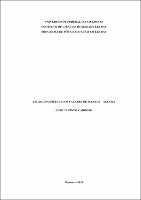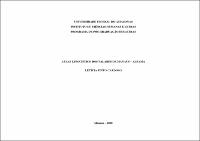| ???jsp.display-item.social.title??? |


|
Please use this identifier to cite or link to this item:
https://tede.ufam.edu.br/handle/tede/6724| ???metadata.dc.type???: | Dissertação |
| Title: | Atlas Linguístico dos Falares de Manaus – ALFAMA |
| Other Titles: | Atlas of Speeches from Manaus – LASM |
| ???metadata.dc.creator???: | Cardoso, Letícia Pinto  |
| ???metadata.dc.contributor.advisor1???: | Cardoso, Maria Luiza de Carvalho Cruz |
| ???metadata.dc.contributor.referee1???: | Campos, Maria Sandra |
| ???metadata.dc.contributor.referee2???: | Martins, Silvana Andrade |
| ???metadata.dc.description.resumo???: | Mapear os falares de pontos geográficos previamente delimitados constitui a finalidade dos atlas linguísticos. O presente trabalho, intitulado Atlas Linguístico dos Falares de Manaus – ALFAMA – se insere nessa iniciativa de apresentar, a partir da aplicação de questionário fonético-fonológico, os falares de uma região, no caso Manaus, cidade que não havia sido investigada pelo Atlas Linguístico do Amazonas – ALAM. Assim, o ALFAMA, composto por dois volumes, a partir do aporte da Dialectologia e o enfoque sociolinguístico, selecionou quatro bairros representativos da capital do Amazonas, são eles: Alvorada (Zona Centro-Oeste), São Raimundo (Zona Oeste), Educandos (Zona Sul) e Colônia Antônio Aleixo (Zona Leste), escolhendo seis informantes em cada um deles, homens e mulheres, distribuídos cada um em três faixas etárias (18 a 35 anos, 36 a 55 anos e 56 anos em diante), com nível de escolaridade baixo, isto é, que fossem iletrados ou que tivessem estudado até a 8ª série do Ensino Fundamental. Ademais, buscou-se aplicar o questionário aos 24 informantes que fossem manauaras ou que para a cidade tivessem se mudado muito cedo, levando-se em consideração que Manaus, como capital e principal centro econômico da região Norte, é composta de muitos fluxos migratórios. A partir desses critérios, foram realizadas 159 questões cujo objetivo era coletar fenômenos fonéticos, ligados a aspectos do vocalismo e consonantismo do português brasileiro. As respostas foram inseridas no programa de geração de cartas linguísticas SGVCLin (Software para Geração e Visualização de Cartas Linguísticas), de autoria de Seabra, Romano e Oliveira (2015), e compõem o segundo volume deste atlas. Entre os resultados destacados, ressalta-se a realização fechada das vogais médias pretônicas anterior e posterior; a manutenção do ditongo [ey] e o apagamento do ditongo [ow]; o -R pós-vocálico com realização predominante para a fricativa glotal surda e -S em coda silábica com predominância para as fricativas pós-alveolares. Assim, com a realização deste atlas, pretende-se contribuir para o conhecimento da realidade linguística da região Norte e estimular a produção de outras pesquisas dialetológicas na capital amazonense. |
| Abstract: | To map out the speeches of geographical spots previously delimited is the purpose of the linguistics atlas. This paper, entitled Linguistics Atlas of Speeches from Manaus - LASM - introduces itself in the initiative of presenting, with the application of a phonetic-phonological questionnaire, the speeches of a region, Manaus for this matter, a city which had not been investigated by the Amazon Linguistics Atlas – ALA. Thus, the LASM, composed of two volumes, with the assessment of Dialectology and the sociolinguistic approach, has selected four representative districts from the capital of Amazonas, which are: Alvorada (Middle West Area), São Raimundo (West Area), Educandos (South Area) and Colônia Antônio Aleixo (East Area), choosing six informers on each of them, men and women, disposed each one on three age groups (18 to 35 years old, 36 to 55 years old and 56 upward), with low educational level, that is, were illiterate or had an educational level up to the 8th grade on elementary school. Furthermore, it sought to apply the questionnaire to 24 informers who were manauaras or those who had moved to the city early on, considering that Manaus, as capital and main economical center of North Region, is composed of many migratories flows. From these standards, 159 questions were made with the purpose of collecting phonetical phenomenon, connected to the aspects of vocalism and consonantism within the brazilian portuguese. The answers were inserted on the linguistics letter generating software SGVCLin (Software para Geração e Visualização de Cartas Linguísticas), designed by Seabra, Romano e Oliveira (2015), composing the second volume of this atlas. Among the results, it was made notable the closed execution of the anterior and posterior pretonical middle vowels, the diphthong management [ey] and the diphthong fading [ow]; the -R post-vocal with predominance to the deaf glottical fricative and -S in syllabical coda with predominanceto to the post-alveolar fricatives. Thus, with the making of this atlas, its purpose is to contribute to the knowledge of linguistic reality of the North Region and to incite the production of other dialectological researches on the amazonian capital. |
| Keywords: | Dialetologia Atlas Fonética/Fonologia - Manaus |
| ???metadata.dc.subject.cnpq???: | LINGUÍSTICA, LETRAS E ARTES: LINGUÍSTICA: SOCIOLINGUÍSTICA E DIALETOLOGIA |
| Language: | por |
| ???metadata.dc.publisher.country???: | Brasil |
| Publisher: | Universidade Federal do Amazonas |
| ???metadata.dc.publisher.initials???: | UFAM |
| ???metadata.dc.publisher.department???: | Faculdade de Letras |
| ???metadata.dc.publisher.program???: | Programa de Pós-graduação em Letras |
| Citation: | CARDOSO, Leticia Pinto. Atlas Linguístico dos Falares de Manaus – ALFAMA. 2018. 119 f. Dissertação (Mestrado em Letras) - Universidade Federal do Amazonas, Manaus, 2018. |
| ???metadata.dc.rights???: | Acesso Aberto |
| URI: | https://tede.ufam.edu.br/handle/tede/6724 |
| Issue Date: | 24-Jul-2018 |
| Appears in Collections: | Mestrado em Letras |
Files in This Item:
| File | Description | Size | Format | |
|---|---|---|---|---|
| DissertaçãoV.I_LeticiaCardoso_PPGL | V.I | 3.32 MB | Adobe PDF |  Download/Open Preview |
| DissertaçãoV.II_LeticiaCardoso_PPGL | V.II | 30.85 MB | Adobe PDF |  Download/Open Preview |
Items in DSpace are protected by copyright, with all rights reserved, unless otherwise indicated.




